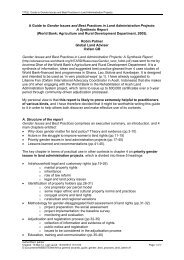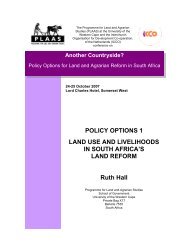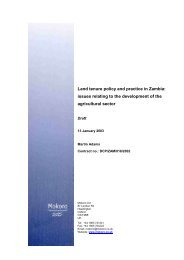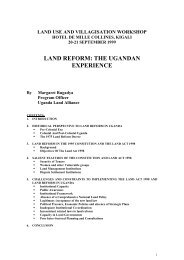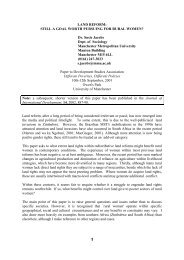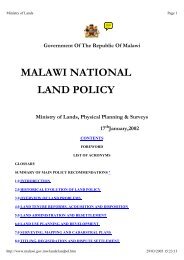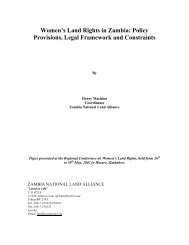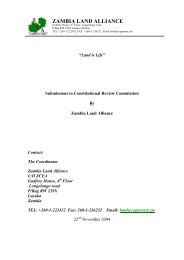The 1999 Land Act and Village Land Act - Mokoro
The 1999 Land Act and Village Land Act - Mokoro
The 1999 Land Act and Village Land Act - Mokoro
Create successful ePaper yourself
Turn your PDF publications into a flip-book with our unique Google optimized e-Paper software.
<strong>The</strong> <strong>1999</strong> <strong>L<strong>and</strong></strong> <strong>Act</strong> <strong>and</strong> <strong>Village</strong> <strong>L<strong>and</strong></strong> <strong>Act</strong> 12approach (see Sundet 1997). <strong>The</strong> group, which was chaired by Prof. Anna Tibaijuka, hadchallenged the Commission’s advocacy for an ‘evolutionary approach’, arguing that ‘hard law’was the only way to deal effectively with gender discrimination in l<strong>and</strong> ownership 12 (LTG 1995,44).It is not likely that this important provision will lead to an overnight revolution in the rights ofwomen to l<strong>and</strong> in rural Tanzania. <strong>The</strong> capacities effectively to oversee <strong>and</strong> enforce the law arenot there <strong>and</strong>, as argued below, the established system of mediation, conflict resolution <strong>and</strong>enforcement are ill suited to tackle what are bound to be highly controversial issues. Thisnotwithst<strong>and</strong>ing, the fact that gender equality has been laid down firmly in law, also in referenceto customary rights, represents an important advance. <strong>The</strong>re is little doubt that it might have areal effect on the situation on the ground in the longer term.Conflict resolution<strong>The</strong> <strong>Act</strong> makes special provisions for the establishment of a <strong>Village</strong> <strong>L<strong>and</strong></strong> Council “to mediatebetween <strong>and</strong> assist parties to arrive at a mutually acceptable resolution on any matters concerningvillage l<strong>and</strong>” (s. 60). For some reason, its jurisdiction has been limited to cases related to l<strong>and</strong>sharing arrangements with other villages (s. 11), or l<strong>and</strong> sharing arrangements betweenpastoralists <strong>and</strong> agriculturalists (s. 58). <strong>The</strong> <strong>Village</strong> <strong>L<strong>and</strong></strong> Council shall consist of seven people,to be nominated by the <strong>Village</strong> Council <strong>and</strong> approved by the <strong>Village</strong> Assembly. Three of themembers shall be women.<strong>The</strong> <strong>Village</strong> <strong>L<strong>and</strong></strong> Council is not a village l<strong>and</strong> court like the Elders’ <strong>L<strong>and</strong></strong> Council recommendedby the <strong>L<strong>and</strong></strong> Commission (Baraza la Wazee la Ardhi). Firstly, its jurisdiction is severely limited,<strong>and</strong> secondly, it only functions in a mediating capacity. Its brief is to assist the aggrieved partiesto arrive at a mutually acceptable solution. In the event that this is not possible, the conflict maybe referred to the courts. In other words, the parties to the dispute are not compelled to follow therecommendation of the <strong>Village</strong> <strong>L<strong>and</strong></strong> Council. It is also noteworthy that the <strong>Act</strong> explicitly statesthat: “No person, or non-village organization shall be compelled or required to use the servicesof the <strong>Village</strong> <strong>L<strong>and</strong></strong> Council for mediation in any dispute concerning village l<strong>and</strong>.” (s. 61 (6)).<strong>The</strong> latter provisions make it quite clear that the <strong>Village</strong> <strong>L<strong>and</strong></strong> Council is only to provide theservice of arbitration between consenting parties. Strictly speaking, it is not even a quasi-judicialbody. It seems surprising that while going to the pains of creating a potentially useful body as the<strong>Village</strong> <strong>L<strong>and</strong></strong> Council, the Government should choose to delimit its powers to the extent ofstripping it of any legal judicial st<strong>and</strong>ing. <strong>The</strong> <strong>L<strong>and</strong></strong> Commission’s principal purpose behindestablishing the Elders’ <strong>L<strong>and</strong></strong> Council, for example, was to bring the judicial system within thereach of the common villager, <strong>and</strong> to set it in a context that would be more underst<strong>and</strong>able <strong>and</strong>legitimate. <strong>The</strong> <strong>Village</strong> <strong>L<strong>and</strong></strong> Council will not serve this bridging function, as long as any partyto a dispute can lawfully choose to ignore it.<strong>The</strong> enabling legislationAs can be seen from the above, the legal <strong>and</strong> regulatory framework for village l<strong>and</strong> lays downextraordinarily complex procedures of l<strong>and</strong> administration. <strong>The</strong> sheer weight of the technicalpaper work prescribed is perhaps best illustrated by the enabling legislation. <strong>The</strong> <strong>1999</strong> <strong>Village</strong>12 <strong>The</strong> <strong>L<strong>and</strong></strong> Tenure Study Group 1995, 44. Also see the discussion on the same in Sundet 1997, Chapter 6.




